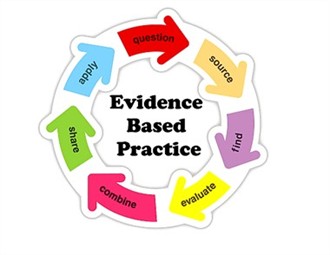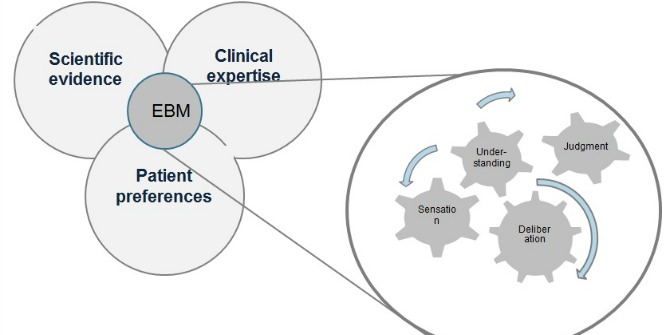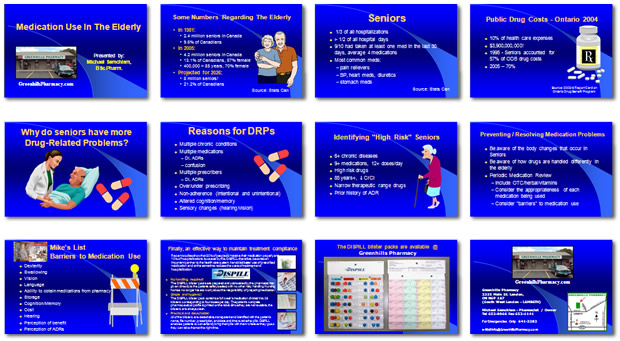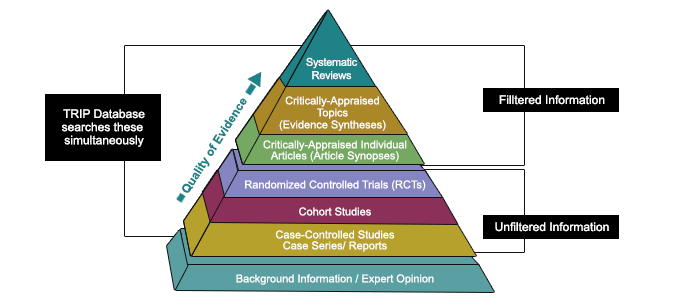Indice degli argomenti
-
This is an individual project-based course where you will learn how to link evidence in medical research to a patient problem you have chosen to examine. It will guide you to prepare a patient case presentation for your final exam.
To prepare for the exam, read the forums and articles,, use the links to the EBM study resources and watch the videos. You will also find descriptions of the written and oral exams (including questions) to help you prepare well. Your extensive contact with English will be through the steps of the EBM process in the cycle of Evidence Based Practice.
The skill you develop here will be essential for your thesis to complete your medical degree and, more importantly, for your future clinical studies and research.

-
Read this for exam descriptions and study tips.
-
-
All the resources to help you to prepare your project for your final exam are here. The exam has 3 components and consists of a Patient Case presentation (15/30) a short search strategy exercise (5/30) and the reading of a clinical paper (10/30). A more detailed description of the exam and the questions can be found in the Forum above.
The project should encourage you to read a number of clinical papers. This will help you read more efficiently and quickly in English. The slides and descriptions here will guide you in the development of your presentation. You should explore the internet links and build your knowledge around basic notions of Evidence-Based Medicine in all of the following sections:

Section 2. Critical Perspectives on EBM will give you a good understanding of the major issues today in our understanding of clinical evidence.They describe the strengths and weaknesses of Evidence-Based Medicine which is a question in the oral exam.
Section 3. Exam Presentation Guide shows you how to structure your Powerpoint for the oral exam and the assessment criteria used to give you marks in the exam.
Section 4. Study Designs gives you links to explanations of different study designs in medicine and their uses in medical research. You need to recognizes and understand the different types.
Section 5. on Asking Clinical Question. This is key to your presentation, and also to the written exam. Don't forget to do the online practice test with PICO!.
Sections 6 - 7. Online Resources and Key Readings links to resources and videos to deepen your knowledge of clinical research including the 3 classic papers by Trisha Greenhalgh from the British Medical Journal.
Section 8. Bibliographic Software, gives you the links to download the free software to organize your reference lists. A must for the exam.
Remember that your EBM project should begin with a patient you have met in the hospital. By choosing to start with a patient in a clinical area which interests you, you will be in a good position to make this project really useful to you as a future doctor.
-
The papers and videos below will give you a good critical perspective on EBM. This will help you answer the question in the oral exam such as: What is EBM? What are its limits and strengths? Spend time studying these and take notes on each to prepare for the final exam
-
Watch the video on BioMed Central and listen to two leading researchers talk about EBM and its strengths and weaknesses (you can activate subtitles in English!). Trish Greenhalgh is Professor of Primary Health Care and Dean for Research Impact at Bart's and the London School of Medicine and Dentistry, UK, while Neal Maskrey is Professor of Evidence-informed Decision Making at Keele University, UK.
Both share a background in General Practice and are advocates of the campaign for real evidence-based medicine. Here Greenhalgh and Maskrey discuss the origins of evidence-based medicine, how it has gone astray, and what is needed to address some of the problems facing evidence-based practice today.

-
In the oral exam you will be asked general questions about Evidence-Based Medicine:
For example: What is EBM? Can you give a definition? What are its strengthen and weaknesses?
What types of study designs do you know? How are they different? What different clinical questions do they answer? The link to the paper Pros and Cons gives a detailed overview of the strengths and weakness to help you answer these questions. The resources links are also very recommended.
-
This is a stimulating 14 minute talk on 'bad science 'by Ben Goldacre. It explains how important 'transparency' in clinical evidence is but also how easily evidence can be manipulated. You can listen to this talk with Italian subtitles. It provides a philosophical background to your EBM project and the idea of 'critical analysis'.
-
These notes on EBM are by Theodore J Gaeta, DO, MPH, FACEP.

-
This is a short paper on types of bias in clinical research. Use it to help you analyse potential bias in your presentation
-
-
This section gives you a detailed guide to create and organise your Powerpoint slide presentation. Before starting, you will need to choose a clinical area that interests you, and find a patient case in a ward you are working in for your studies. Your case presentation should not be theoretical. Base it instead on a case you have experienced in the hospital.
After collecting your evidence present your synthesis using Powerpoint or Keynote in a 10 minute oral presentation. Follow the guideline closely to structure your presentation with approximately 12-16 slides

-
This guide describes what information to include in your presentation, the titles you need to put on every slide, how many slides to use, and how to present the material. Your EBM presentation in the exam is worth 15/30.
The table below has 15 sections. Each section explains criteria for 1 mark in the exam. Follow it carefully while you prepare your slides.

-
-
The links here explain study design to help you recognize different kinds of clinical papers and understand their purposes. In the exam you need to know the different types of study design and explain how each design answers a different kind of clinical question.

-
These notes on EBM are by Theodore J Gaeta, DO, MPH, FACEP Assoc Prof Emergency Medicine. The link http://www.cebm.net/study-designs/ also provides a summary of pros and cons of different designs
-
Asking the right questions is key to research. In any field! It is the start of your EBM presentation and an execrise in the written exam.1. Watch the video and study the links which give a number of examples.2. Do the two online quizzes to help you develop your skill in identifying the components of a clinical question in English.
In each test there are some some short clinical scenarios. From each scenario you must identify the PICO components from a pull down selection.
-
Here is a short presentation describing PICOT (in case you have forgotten!) It explains the process of research preparation. This is a good guide for the exam! There are many other YouTube films and presentations on the internet you can consult for more help.
-
This is a resource to help you refine your clinical questions.
-
How do you write a focussed clinical question? This link will give you a head start using PICO to commence your EBM project. In the exam you must demonstrate you can do this (4/30)
-
Here is another exercise to help you improve your ability to identify the components of a clinical question using the PICO methodology. Read the case descriptions and choose the best options in the multiple choice questions. You can do this up to 3 times!

-
-
What exactly is EBM? Here are essential resources to read and study. They will give you the basic tools to critically analyse the evidence you collect from medical databases. This ability to 'appraise critically' the medical literature is the heart of the EBM project, and also you ability to use evidence to inform decisions about your patient.
To successfully complete the exam you need to be able to demonstrate you can critically evaluate medical research. These resources will help you to develop your evaluation skills. Read all, and carefully!
-
I recommend you explore the GIMBE web site. It is a pioneer site in Italian to spread knowledge about the basics of EBM.
-
The TRIP Plus database is a meta-search engine that searches across multiple sites of high-quality medical information, including PubMed's Clinical Inquiries. TRIP Plus is an electronic resource.
-
Listen to a short Podcast on RCTs and their strengths and weaknesses
Randomized Trials Stopped Early for Benefit: Interview With Dr Victor Montori
Released23 May 2011
Victor Montori, MD, discusses randomized trials that are stopped early for benefit.
-
-
As well as the links on this site to EBM resources here are some key readings on 'How to read clinical papers" critically. Use them to help you critically analyze the papers you include in your evaluation of evidence during your case presentation
-
This papers gives a worked example of how to critically appraise a clinical study. It gives you a clear tool to analyses the papers in your own presentation. Spring07.pdf
-
Bibliographic software makes research a lot easier. For this reason, all students must use one in preparation for the final exam. This will help you to create professional references easily and to organize systematically clinical papers related to your studies. Here are two free versions you can choose from - Mendeley and Zotero - but you can choose others if you prefer.
-

All students need to choose one referencing software. This is a professional tool for all research, and is also essential for your thesis. The free software applications will make your bibliographies accurate and professional. Click on the link to download Mendele. http://www.mendeley.com
-
Using Bibliographic Software
INSTRUCTIONS FOR INSERTING CITATIONS into your documents USING MENDELEY:
Some students have had problems inserting citations from their Mendeley library using Microsoft Word. You need to do this to complete the short summary exercises for each module online.So here is some help to solve the problem. After you download the free software 'Mendeley Desktop,' follow these instructions.
1. Download the Microsoft Word plug in for your browser from the link below
2. The plug-in gives you a link to Mendeley from your Microsoft Word toolbar.
3. From the menu choose the citation style (e.g. ‘Nature) for a Word document, or Harvard for a Power point presentation.
4. Put the cursor where you want to insert the references in your document
5. From the menu slect ‘Insert citation >Go to Mendeley and select the paper (or papers) you want to cite. Select the ‘Cite’ icon from the menu in your library. Mendeley will insert in-text numbers1
6. At the end of your work write the word ‘References,’ then select ‘Insert bibliography from the plug in menu in Word
References (example using citation style ‘Nature’)
1. Alon, U. How to choose a good scientific problem. Mol. Cell 35, 726–728 (2009).
-
-
You must present a professional reference list, of publications, texts, images and web sites that you have used for your presentation. Refer to the link here from the US National library of Medicine for how to cite different kinds of texts.
-
-
To start, talk to your medical tutor about the patient case you would like to select. With permission, consult the clinical record and talk to the patient. Discover as much as you can about the problem.
Your tutor can guide you on problematic areas on which an EBM investigation will be useful - that is whether your question is worth asking, and perhaps even some key papers you should search for. The best presentations are when students have this kind of clinical guidance from their clinical tutors on the wards.
 As you create your presentation, check each section of your slide show with the guidelines in Section 3 above. This should normally be sufficient for the exam. Only when you are satisfied with your first draft, and have used the guidelines, but still feel unsure, should you send me your presentation in Powerpoint (ppt) or Key Note (for Mac) formats.
As you create your presentation, check each section of your slide show with the guidelines in Section 3 above. This should normally be sufficient for the exam. Only when you are satisfied with your first draft, and have used the guidelines, but still feel unsure, should you send me your presentation in Powerpoint (ppt) or Key Note (for Mac) formats. See the dates on INFOSTUD for sending me your emails requesting feedback at snelgrovehuon@me.com -this is normally one week before the exam date.
See the dates on INFOSTUD for sending me your emails requesting feedback at snelgrovehuon@me.com -this is normally one week before the exam date.


